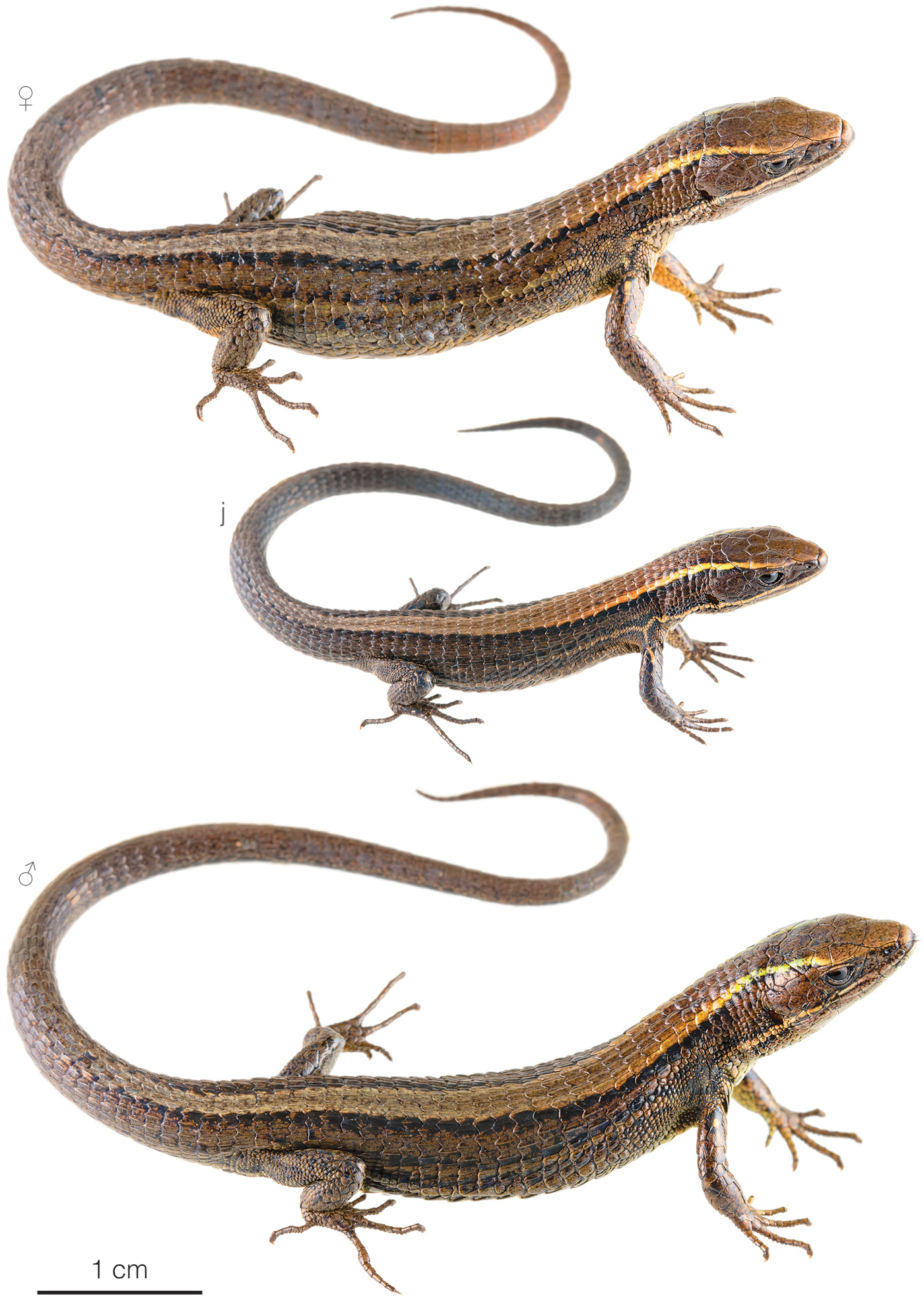Published September 26, 2021. Updated November 26, 2023. Open access. Peer-reviewed. | Purchase book ❯ |
Green-striped Sticklizard (Pholidobolus samek)
Reptiles of Ecuador | Sauria | Gymnophthalmidae | Pholidobolus samek
English common name: Green-striped Sticklizard.
Spanish common names: Cuilanpalo de franjas verdes, cuilán de franjas verdes.
Recognition: ♂♂ 12.7 cmMaximum distance from the snout to the tip of the tail. Snout–vent length=4.6 cm. ♀♀ 11.3 cmMaximum distance from the snout to the tip of the tail. Snout–vent length=4.5 cm..1,2 Sticklizards differ from other lizards by having short but well-developed limbs, overlapping striated sub-hexagonal dorsal scales, a brownish dorsal pattern with longitudinal stripes, and no prefrontal scales.3,4 The presence of six-sided finely wrinkled dorsal scales distinguishes Pholidobolus from other co-occurring small brownish lizards such as those in the genera Alopoglossus, Anadia, Andinosaura, Macropholidus, and Riama.5 The Green-striped Sticklizard (P. samek) is the only species of its genus known from its range of distribution. It is easily differentiated from other small brownish lizards by having green dorsolateral stripes on the head.1 Males of P. samek differ from females by having a broader head and a slightly more intense coloration.

Figure 1: Individuals of Pholidobolus samek from Yacuri National Park, Zamora Chinchipe province, Ecuador.
Natural history: Pholidobolus samek is a rare lizard at the type locality, Cerro Plateado Biological Reserve, but occurs in high densities in a new locality in Yacuri National Park. The species inhabits pristine to moderately disturbed cloud forests as well as roadcuts passing through these ecosystems.1,2 At the type locality, Green-striped Sticklizards were active between 11:30 am and 5:00 pm under rocks or ground bromeliads.1 The ground at the plateau of Cerro Plateado is covered with mosses, roots, and bromeliads.1 Four eggs, presumably from different clutches, were collected in September,1 which suggest females of this species might use communal nesting sites. At the new locality reported here, one nest found in July contained 26 eggs.2 The adult lizards near the nest were found hidden under rocks during a cloudy day.2
Conservation: Critically Endangered Considered to be facing imminent risk of extinction..1 Pholidobolus samek was proposed to be included in this threat category at the time of description. The rationale is that the species’ known range is extremely narrow and large-scale habitat fragmentation and destruction is evident just a few kilometers from the type locality.1 Although one population is currently within the limits of the Cerro Plateado Biological Reserve and the other in Yacuri National Park, small and large-scale mining activities are a significant threat that could extirpate both populations within a short time period.1
Distribution: Pholidobolus samek is endemic to the Amazonian slopes of the Andes in southeastern Ecuador, where it is known only from Zamora Chinchipe province.1 Although a new locality record (Appendix 1) is presented here, genetic analyses will ultimately confirm if lizards from the new area actually belong to P. samek (Fig. 2).

Figure 2: Distribution of Pholidobolus samek in Ecuador. The star corresponds to the type locality: Cerro Plateado Biological Reserve. See Appendix 1 for a complete list of the presence localities included in the map.
Etymology: The generic name Pholidobolus comes from the Greek words pholidos (=scale) and bolos (=lump),6 and probably refers to the imbricated or mounted scales. The specific epithet samek means “green” in the Shuar language. It refers to the green dorsolateral head stripes.1
See it in the wild: Pholidobolus samek is a rare species that was, until recently, known only from its type locality, where only one adult male, two adult females, and four eggs were found despite days of intense fieldwork. At the new locality in Yacuri National Park, individuals were easy to find under rocks along a dirt road.
Author: Amanda QuezadaaAffiliation: Tropical Herping (TH), Quito, Ecuador.,bAffiliation: Laboratorio de Herpetología, Universidad del Azuay, Cuenca, Ecuador.
Editor: Alejandro ArteagacAffiliation: Fundación Khamai, Reserva Arlequín, Ecoruta Paseo del Quinde km 56, Santa Rosa de Mindo, Pichincha 171202, Ecuador.
Academic reviewer: Jeffrey D CamperdAffiliation: Department of Biology, Francis Marion University, Florence, USA.
Photographer: Jose VieiraaAffiliation: Tropical Herping (TH), Quito, Ecuador.,eAffiliation: ExSitu, Quito, Ecuador.
How to cite? Quezada A (2023) Green-striped Sticklizard (Pholidobolus samek). In: Arteaga A, Bustamante L, Vieira J (Eds) Reptiles of Ecuador: Life in the middle of the world. Available from: www.reptilesofecuador.com. DOI: 10.47051/TNKI2703
Literature cited:
- Parra V, Sales Nunes PM, Torres-Carvajal O (2020) Systematics of Pholidobolus lizards (Squamata, Gymnophthalmidae) from southern Ecuador, with descriptions of four new species. ZooKeys 954: 109–156. DOI: 10.3897/zookeys.954.50667
- Field notes, Reptiles of Ecuador book project.
- Montanucci RR (1973) Systematics and evolution of the Andean Lizard genus Pholidobolus (Sauria: Teiidae). Miscellaneous Publications of the Museum of Natural History, University of Kansas 59: 1–52.
- Torres-Carvajal O, Venegas P, Lobos SE, Mafla-Endara P, Sales Nunes PM (2014) A new species of Pholidobolus (Squamata: Gymnophthalmidae) from the Andes of southern Ecuador. Amphibian & Reptile Conservation 8: 76–88.
- Peters JA, Donoso-Barros R (1970) Catalogue of the Neotropical Squamata: part II, lizards and amphisbaenians. Bulletin of the United States National Museum, Washington, D.C., 293 pp.
- Brown RW (1956) Composition of scientific words. Smithsonian Books, Washington D.C., 882 pp.
Appendix 1: Locality data used to create the distribution map of Pholidobolus samek in Ecuador (Fig. 2). Go to the section on symbols and abbreviations for a list of acronyms used. Asterisk (*) indicates type locality.
| Country | Province | Locality | Source |
| Ecuador | Zamora Chinchipe | Cerro Plateado Biological Reserve* | Parra et al. 2020 |
| Ecuador | Zamora Chinchipe | Yacuri National Park | This work |